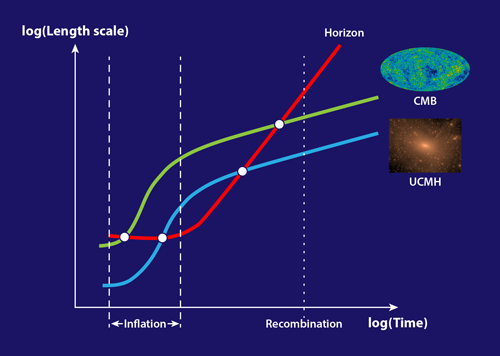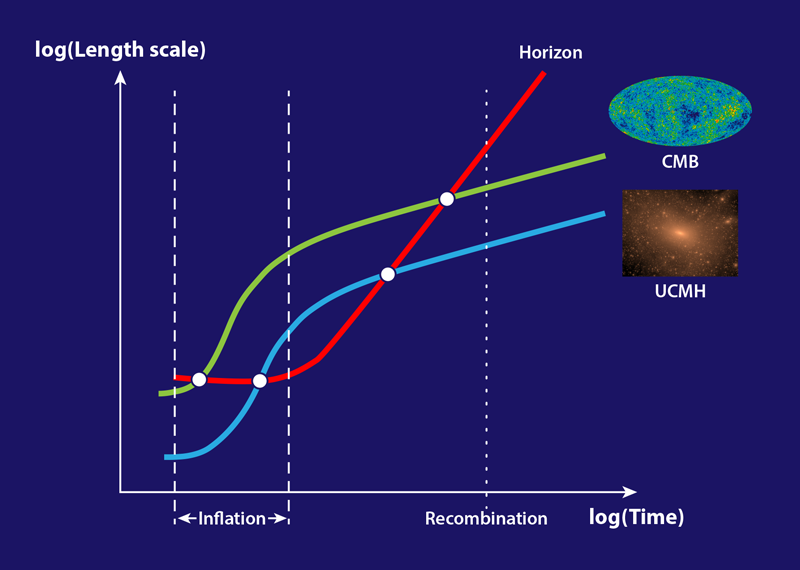Cosmic Clues from Mini Clumps of Dark Matter
The very early Universe lies beyond our direct observation. Electromagnetic radiation from this time period was continuously scattered by a hot and opaque plasma of charged particles that filled the Universe. It wasn’t until 300,000 years after the big bang that neutral hydrogen formed from these free protons and electrons (in a process called recombination), and electromagnetic radiation was finally able to travel unimpeded across the now transparent Universe. This light offers us a direct view of the cosmos at the time of recombination, and from that picture we can try to infer what was happening before.
However, there is an alternative access to the very early Universe through the cosmological “fossil” record. These objects were created before recombination and have been preserved in some pristine fashion, giving an indication of what conditions were like when they formed. One possible type of fossil candidate are ultracompact minihalos (UCMHs)—dense clumps of dark matter, much smaller than galaxies—that are presumed to have formed during a very early expansion stage called inflation but have so far not been detected. Grigor Aslanyan from the University of Auckland, New Zealand, and colleagues have used the current observable limits on ultracompact minihalos, from pulsar timing and bright sources of gamma rays, to provide new and complimentary information as to the details of cosmological inflation [1]. Specifically, the authors constrain models for how inflation generates the density perturbations that eventually lead to galaxies and other massive structures.
The theory of cosmological inflation, which originated in the 1980s, assumes that the Universe underwent a period of accelerated expansion at very early times ( 10−35 s) [2]. As well as solving some other problems with the standard cosmological model, inflation predicts a spectrum of primordial density perturbations, generated by quantum vacuum fluctuations that are expanded to macroscopic size by the Universe’s accelerated expansion. After inflation ends, these perturbations grow under gravity, giving rise to dense and empty regions in the sky. This distribution is observable in the warm and cool patches of the cosmic microwave background (CMB) [3], which is the light that was emitted at recombination. The density distribution is also observable in the pattern of galaxies and other massive structures in the Universe today [4].
To study these density perturbations, researchers analyze them in terms of their length scale, or wavelength. Because of the cosmic expansion, these length scales were smaller in the past. For example, a typical galaxy cluster might presently span 10 megaparsecs (roughly 30 million light years), but at the time of recombination, this length scale would have been a factor of a thousand smaller. The model of inflation most favored by the CMB measurements predicts that the initial density distribution (or power spectrum) is very slightly “red,” meaning it predicts larger amplitudes for perturbations of large wavelength and smaller amplitudes for perturbations of smaller size. However, cosmologists would like to test this, since the shape of the power spectrum can provide information about the mechanism that drives inflation.
The connection between the density distribution and the inflation model can be understood by considering the evolutionary history of a perturbation. Before inflation, the perturbation’s length scale is microscopic in size, but once inflation starts, particles within the perturbation are rapidly separated. This accelerated expansion can in fact generate an event horizon, where such particles become causally disconnected (similar to the disconnection that occurs when a particle falls into a black hole). If the perturbation’s length scale expands beyond this horizon, its density can no longer evolve, so it becomes static (see Fig. 1). After inflation ends, the horizon starts to expand, as causal forces start to “catch up” with particles that were once disconnected. This means that large-scale perturbations can start to gravitationally evolve, driving the formation of structure in the Universe.
Most cosmological surveys, such as CMB observations and large-area galaxy maps, make measurements on perturbations over the largest scales that—at the present time—correspond to distances between 10 megaparsecs and 100 gigaparsecs. During the inflation epoch, these length scales were some of the first to expand beyond the horizon, so they provide information about the early stages of inflation. To probe later stages of inflation, Aslanyan and colleagues turn to smaller scales, all the way from 0.1 megaparsecs down to 10−7 megaparsecs, which are the scales of UCMHs.
First suggested in 2003 [5], UCMHs are dense clumps of dark matter that became gravitationally bound after inflation ended, but long before recombination. Once formed, they cannot easily be dispersed again, except by other gravitational interactions. For such dark matter halos to have survived to the present day without annihilating or being disrupted, they must be very dense and small. If UCMHs were detected in large quantities, it would imply higher than expected power at small scales of the density distribution, which would be the signature of a more “blue” power spectrum, currently at odds with the CMB data.
One way dark matter minihalos would manifest themselves would be through gravitational lensing events, briefly brightening a distant astronomical source while passing in front of it. They would therefore present a similar observational signature to that of massive compact halo objects, or MACHOS, which were suggested as a dark matter candidate in the 1980s and ruled out by observational searches [6]. UCMHs might also be identified through the direct detection of the decay products of dark matter, which would appear as high-energy gamma rays. No such signal has yet been seen by the Large Area Telescope on the Fermi satellite [7]. Finally, highly accurate measurements of pulsar timing would also be disrupted by the presence of UCMHs, as the travel time for the radio signals would suffer a delay due to the Shapiro effect [8]. The lack of detection in all these measurement channels put significant limits on the size and density of UCMHs.
Aslanyan and his team take these UCMH limits and apply them to the parameter space that characterizes different inflation models. They show that certain regions of this parameter space are ruled out by observations. UCMHs have been utilized to investigate the early Universe before (see, e.g., Ref. [9]). Aslanyan and his team have, for the first time, provided a direct connection between the physics of inflation and the UCMH distribution. By simulating the evolution of the perturbations during inflation, and then predicting the mass and abundances of UCMHs, they find that their nondetection is still a useful constraint on the details of inflation. This approach significantly widens the available observational pathways to understand the early Universe, and so may provide a future key piece of information as to exactly how inflation took place.
This research is published in Physical Review Letters.
References
- G. Aslanyan, L. C. Price, J. Adams, T. Bringmann, H. A. Clark, R. Easther, G. F. Lewis, and P. Scott, “Ultracompact Minihalos as Probes of Inflationary Cosmology,” Phys. Rev. Lett. 117, 141102 (2016).
- A. H. Guth, “Inflationary Universe: A Possible Solution to the Horizon and Flatness Problems,” Phys. Rev. D 23, 347 (1981); A. D. Linde, “A New Inflationary Universe Scenario: A Possible Solution of the Horizon, Flatness, Homogeneity, Isotropy and Primordial Monopole Problems,” Phys. Lett. B 108, 389 (1982); A. Albrecht and P. J. Steinhardt, “Cosmology for Grand Unified Theories with Radiatively Induced Symmetry Breaking,” Phys. Rev. Lett. 48, 1220 (1982).
- P. A. R. Ade et al., “Planck 2013 Results. I. Overview of Products and Scientific Results,” Astron. Astrophys. 571, A1 (2014).
- A. G. Sánchez et al., “The Clustering of Galaxies in the SDSS-III Baryon Oscillation Spectroscopic Survey: Cosmological Implications of the Large-Scale Two-Point Correlation Function,” Mon. Not. R. Astron. Soc. 425, 415 (2012).
- V. Berezinsky, V. Dokuchaev, and Y. Eroshenko, “Small-Scale Clumps in the Galactic Halo and Dark Matter Annihilation,” Phys. Rev. D 68, 103003 (2003).
- C. Alcock et al., “The MACHO Project: Microlensing Results from 5.7 Years of Large Magellanic Cloud Observations,” Astrophys. J. 542, 281 (2000).
- T. Bringmann, P. Scott, and Y. Akrami, “Improved Constraints on the Primordial Power Spectrum at Small Scales from Ultracompact Minihalos,” Phys. Rev. D 85, 125027 (2012).
- H. A. Clark, G. F. Lewis, and P. Scott, “Investigating Dark Matter Substructure With Pulsar Timing—I. Constraints on Ultracompact Minihaloes,” Mon. Not. R. Astron. Soc. 456, 1394 (2015).
- Massimo Ricotti and A. Gould, “A New Probe of Dark Matter and High-Energy Universe Using Microlensing,” Astrophys. J. 707, 979 (2009).





